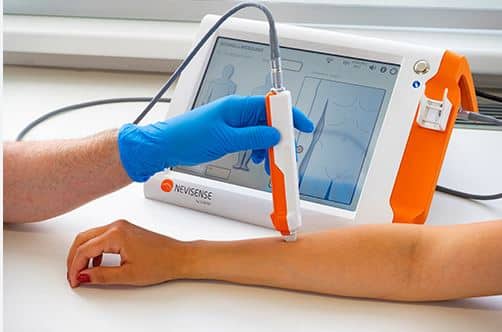
Cutting-edge technology designed to address the limitations of traditional melanoma detection methods.
Melanoma is one of the most common cancers among adults. It affects people of all ages, races and regions. We are proud to be offering patients a revolutionary technology in Melanoma detection with Nevisense. It is FDA approved, non-invasive, and highly accurate allowing for early detection of potential melanomas without the need for skin biopsies.
In one simple procedure, Nevisense transmits small electrical signals beneath the skin’s surface to collect highly accurate information that is unavailable through any other method. The results are immediate, allowing Dr. Ablon to more thoroughly examine irregular lesions and decide on appropriate actions during your visit.
How It Works
The Nevisense test is simple and is typically painless. The device sends small electrical impulses into the skin’s surface – impulses so small that they cannot be felt when the measurement is taken. The only thing you are likely to feel is the handpiece touching your skin. Nevisense measures skin properties that cannot be seen, such as cell structure, shape and size. The result of the Nevisense test provides additional information to your doctor. Used in combination with other data such as your mole’s appearance, your medical history and other risk factors, it helps to decide whether the mole should be removed.
Side Effects and Risks
There are no know side effects of using this diagnostic tool.
Possible risks of any skin check or test for melanoma include incorrect results. – A false negative result means a mole is melanoma but the test says it is not, or says that it has a low risk of being a melanoma. A false negative may delay treatment melanoma. This can lead to increased illness or death. – A false positive is when a mole is not melanoma but the test wrongly says it is, or says it has a high risk of being melanoma. A false positive may result in removing a mole that is not melanoma.
What can I expect?
Common side effects may include, but may not be limited to, muscular pain, temporary muscle spasm, temporary joint or tendon pain, and redness at or near the treatment site.
Treatments are typically twice a week for 4-6 sessions and then maintenance is quarterly.
